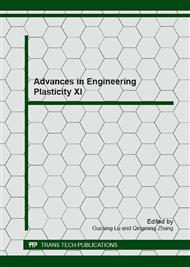p.497
p.501
p.505
p.509
p.514
p.518
p.522
p.526
p.530
Numerical Studies on the Blast-Resistant Capacity of Stiffened Multiple-Arch Panel
Abstract:
Blast-resistant structures are traditionally designed and fabricated with solid materials of heavy weight to resist blast loadings. This not only increases the material and construction costs, but also undermines the operational performance of protective structures. To overcome these problems, new designs with either new structural forms or new materials are demanded against blast loads. A multi-arch double-layered unstiffened panel has been proposed as a new structural form in the previous study[1]. Its performance has been numerically demonstrated better than other forms of double-layered panels in resisting blast loads. In this study, to further improve the effectiveness of the multi-arch double-layered panel in resisting blast loads, responses of a five-arch double-layered panel with rectangular stiffeners to blast loads are investigated by using finite element code Ls-Dyna. Peak displacement, internal energy absorption, boundary reaction forces and plastic strain are extracted and used as response parameters to demonstrate the effectiveness of stiffened panel on the blast resistance capacities. The numerical results show that the stiffened panel outperforms the unstiffened panel of the same weight on the blast-resistant capacity. The stiffened multi-arch double-layered panel has great potential applications in the blast-resistant panel design.
Info:
Periodical:
Pages:
514-517
Citation:
Online since:
January 2013
Authors:
Keywords:
Price:
Сopyright:
© 2013 Trans Tech Publications Ltd. All Rights Reserved
Share:
Citation:


